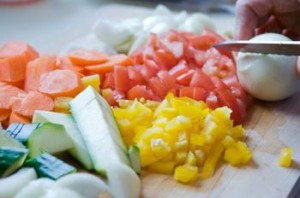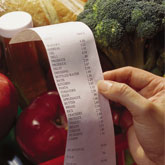Whether your family has two kids or ten kids, grocery bills are adding up for all of us – especially if you’re trying to pick the healthier choices. The most important thing you have to remember is that if you’re trying to eat healthy, and you cannot afford to spend more money, you have to spend more time. Time in the kitchen cooking, time planning out meals for the week, time surfing through the grocery store flyers for sales, et cetera. Try some of the tips I’ve included below to help!
1. Use up ingredients you already have. Before heading to the grocery store, take a look at what you already have tucked away in the pantry to see if you can use it in a dish. Breadcrumbs and canned tomatoes? Pick up some eggplant and make eggplant parmesan. Whole-grain rice and salsa? Pick up some peppers and onions and make a Mexican-inspired rice dish.
2. Buy in bulk when it makes sense. Buying products in bulk can save you a lot of money, but try to only do so if the product is one you would normally eat. Try to also look for the buy-in-bulk deals on healthier options so you don’t fill up your house with junk food.
3. Cook more than one meal at a time. Wondering how this tip saves you money? Cooking extra meals gives you options later on in the week, and can be great if you’re feeling tempted to spend lots of money on expensive takeout or restaurant meals. Knowing that you’ve got a healthy and delicious homemade meal ready to go at home means you’re less likely to spend unnecessary money.
4. Don’t buy more fruits and vegetables than you need. Fruits and vegetables are definitely healthy choices, don’t get me wrong here. But they can also be quite perishable, and the last thing you want to do is be throwing out produce because it’s gone bad before you can get to it. Only buy what you need and make sure to eat the more perishable items first (usually fruits).
5. Take advantage of frozen vegetables. This one helps with the previous tip – you can use up your fresh vegetables earlier in the week, and then rely on frozen veggies to last you until your next grocery store trip! And don’t be worried about using frozen produce – they’re often picked at the peak of their season and immediately frozen, so all those nutrients are locked in.
6. Build meals around cheaper staples. Potatoes, carrots, onions, pasta, and rice are relatively inexpensive staple items, no matter what store you shop at. Utilize their low-cost nature by building meals around them to create healthy options. The key here is to still prepare them in healthier ways – this doesn’t mean making French fries and carrot cake all the time!
7. Get creative in the kitchen. Craving pizza but don’t want to fork over the money to get it delivered, or can’t get to the grocery store? Keep a jar of pizza sauce (or make your own!) in the cupboards and you can make pizza whenever you’d like. If you don’t have access to pizza dough, try using Arnold’s Sandwich Thins or even tortillas! Get a little more creative with your meals and you’ll be able to make the inexpensive ingredients come to life!
8. Use slices or cubes of meat instead of whole pieces. Instead of making meat the star of your meals, make it a team player – include it, but shift the focus to the other ingredients. If you’re creative enough, you can stretch out small portions of pork tenderloin or chicken breast into two family meals with the addition of a whole grain and lots of veggies! Don’t forget, you can get protein from grains, beans, and dairy, so don’t be concerned that you won’t be meeting your needs.
9. Incorporate beans. This might be the easiest tip on the list! Beans are extremely nutritious, delicious, and versatile – add them to salads, pasta, soups, and more! If you haven’t tried beans yet, pick up a can the next time you’re at the store and search for a great recipe to use them. Once you start to enjoy using beans in your cooking, buy dried beans and cook them yourself to save even more money!
10. Grow your own. Whether it’s a small tomato or pepper plant, or herbs like basil, chives, or rosemary, growing your own food can easily help you cut down food costs. Start slowly with just one plant and enjoy eating your own home-grown ingredients!
Assistance provided by Megan Skinner [5]




